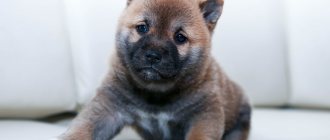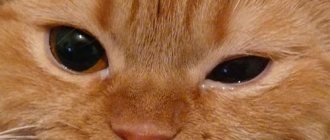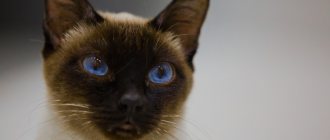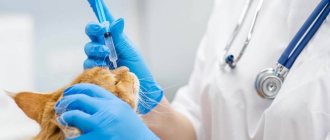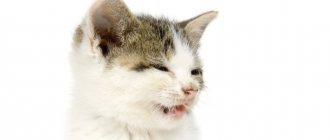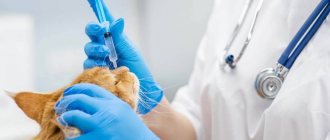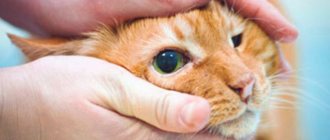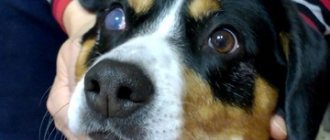14423Pavel
7
Ten days after birth, the kittens’ eyes begin to open, initially narrow slits appear, and then two small buttons glow like beads. This is a normal process. But what to do when the kitten’s eyes do not open? This phenomenon causes concern among owners.
Watching the little beads open is just a pleasure. To begin with, tears appear in the inner corner, then a small crack forms, which increases every day. As a result, small shiny buttons appear. But if your eyes are difficult to open, is it worth doing anything?
How to treat lacrimation at home?
It is important to note that you should not put human medications in your pet's eyes. Firstly, they are ineffective for animals, and secondly, exceeding the dosage can have a detrimental effect on the cat.
As an additional means to the main treatment, you can treat with decoctions of herbs, such as chamomile, sage or calendula. Also, instead of herbs, you can use strong tea leaves or a weak solution of manganese. Such washing helps to get rid of pus in the pet’s eye, stop inflammation, and heal the affected eyeball.
Therapy or surgery?
Depending on the cause of anisocoria and the general health of the cat, a treatment program is selected:
- anti-inflammatory therapy for uveitis;
- elimination of the damaging factor and the use of antibiotics for corneal injury;
- surgery or use of antihypertensive drugs for glaucoma;
- steroid hormones for diseases of the optic nerve;
- removal of a tumor on the operating table.
The cat's recovery is determined by the cause of anisocoria and the adequacy of treatment at home. The owner of the animal must be prepared for the fact that in some cases a long therapeutic course and careful control over the source of the disease will be required.
Anisocoria requires a thorough examination and a competent approach to treatment. That’s why, if you notice that your cat’s pupils are of different sizes, you need to urgently seek professional help from a veterinary clinic. If your pet goes blind, it will be almost impossible to restore his sight.
If for a long time the owners notice that the cat has different pupils, they often suspect health problems. Depending on the symptoms, the cause may not only be an eye disease. A change in the cat's behavior and the obvious consequences of a blow as a result can lead to irreversible consequences if the size of the pupil is not monitored in time.
Reasons for not opening eyes
Cats fight: the main reasons for the behavior and what can be done to wean them off.
The eyes of small kittens open gradually. First, a small crack appears, most often this can be observed from the inside. Then the iris becomes visible. They become cloudy within a week, so you should not expose babies to bright light. Most often, the cat itself brings the cubs out of hiding when the time is right.
Each kitten develops individually. Even within the same litter, some develop faster and more actively than others. There are often situations when the first kitten born begins to see before everyone else.
Late eye opening depends on several factors.
Other Possible Problems
If more than two weeks have passed since birth, and one of the kitten’s eyes does not open, this should alert the owner. This phenomenon may be the cause of the development of a pathological deviation. It is best to show the animal to a doctor.
Important! If the cat's eyes do not open and are watering, this may indicate a foreign body. The appearance of pus indicates the development of conjunctivitis.
Young kittens are very vulnerable to viral infections. Harmful bacteria can come from both the external environment and the womb. Therefore, owners of newborn kittens often experience inflammation of the organs of vision.
Eye is leaking
The reasons why a kitten's one eye is watery can be due to many factors:
- the appearance of infection is the most common phenomenon. The most common are chlamydia, herpes and mycoplasmosis, which are also contagious to humans. The presence of infection can only be determined through analysis of eye wash;
- allergic reactions may occur to food, dust and household chemicals;
- mechanical eye injuries that appear either after active play of kittens or due to burns. A speck of dirt can also get into the kitten’s eye, which will cause injury to the cornea, the eye will begin to hurt and leak;
- infection of an animal with parasites;
- disruption of the gastrointestinal tract;
- prolonged exposure to lighting devices, a bright light source.
Only a doctor can name the exact reason why a kitten’s eyes are watering. The conclusion is made after the diagnosis. As soon as an accurate diagnosis is made, the doctor prescribes how to treat the cat.
Tearing will be considered normal when it comes to Scottish and British breeds. It all depends on the structure of the skull. Due to the fact that these breeds have a flattened muzzle, their eyes are susceptible to the influence of the environment, and they constantly leak. Owners of these breeds should contact a veterinarian if they see changes in their pet's behavior.
Important! You need to monitor the color of the discharge from the eyes. If tearfulness with pus is observed, it is necessary to immediately contact a veterinarian. Pus from the eyes indicates the beginning of the inflammatory process.
A kitten's eye is leaking
If clear discharge without blood or pus is detected, you can get rid of it at home. To do this, you can wash your pet's eyes with tea and chamomile infusion. Products sold in pet stores have a good effect. You can purchase eye drops that will produce results within 2 weeks. If after treatment the cat continues to squint his eyes, they close and run, you need to show him to the veterinarian.
Squints his eyes
Pet owners should be wary if their pet squints one eye. This indicates that he is experiencing pain and discomfort. Most often this is accompanied by severe lacrimation and suppuration. In this situation, you urgently need to show the animal to a doctor and take the necessary measures for treatment. Squinting of the eyes can occur for a number of reasons:
- the development of conjunctivitis is an inflammation of the mucous membrane, which is accompanied by swelling and purulent discharge. The diseased organ of vision becomes swollen, it begins to close and turn red. For treatment, special drops and rinsing are used. If the disease is detected late, antibiotic injections are prescribed;
- mechanical injury to the cornea, accompanied by severe pain. The complexity of such phenomena lies in the fact that microorganisms can enter small cracks in the corneal tissue and subsequently multiply. Particular attention is paid to injuries caused by claws, under which a large number of bacteria accumulate, as well as worm eggs;
- Allergic reactions can be to household chemicals, dust, or to flowers and plants. If a kitten begins to squint its eyes in order to identify the causative agent of the allergy and prescribe treatment, the doctor conducts a diagnosis by taking tests;
- increased eye pressure. Most often, this phenomenon occurs in old animals due to age-related changes. If treatment is not taken, this condition can lead to blindness;
- Corneal erosion or damage to the membrane are the most common reasons why a cat squints. The impetus for infection comes from injuries, burns, and viral infections. If left untreated, the disease will lead to serious consequences such as corneal erosion.
Conjunctivitis
If your pet begins to constantly squint his eyes, you need to urgently take him for examination.
Factors influencing the opening of the eyes
The following factors influence how a kitten's eyes open:
- Breed. In breeds such as Rex and Sphynx, the eyelids open on the second day after birth. Many Sphynx cats are born with their eyelids already open. The offspring of Persian breeds become sighted in the period from 5 to 9 days, Siamese open their eyes on the 5th day, the British are fully sighted on the 10-12th day.
- Accommodations. If kittens are kept in a brightly lit room, it will take a longer period of time for them to fully see.
- Wool length. In smooth-haired pets the process goes faster than in long-haired pets.
- Length of pregnancy in a cat. If the kittens were born on time, then their eyes will open on time.
- Health of mother and offspring. If the pets are healthy, eat properly and the mother takes care of the kittens for a long period, the eyes will open at the appointed time.
About the vision of cats
To clarify the problem and correctly assess the current circumstances, the owner must know about the structure of the kitten’s eye. In relation to the human organs of vision, the eye size of pets is much larger. The retinal area also contains nerve endings or rods. There are almost 7 times more rods than cones, which indicates that furry friends have much better vision than humans, so they see well in the dark.
© shutterstock
The round shape of the eyeball with the lens located at the center helps to expand the viewing angle. The eyes are protected from the effects of external factors, that is, foreign bodies entering the eyelids and mucous membranes. Moreover, cats have three eyelids, and this only enhances their protection.
Research has found that cats see the world in color, and not in black and white, as many people think. It’s not for nothing that the kitten likes to sit next to the screen when watching TV.
How to help kittens open their eyes
What to do if kittens' eyes do not open completely? Is there any way to help your pets solve the problem? You need to follow simple steps:
- Brew a thick tea, judge, strain. Using a cotton swab, treat small cracks with preparation.
- Dilute a weak solution of boric acid and also regularly treat the kittens' eyes.
- If pus is discharged, you should contact a specialist, but for the first time you can provide help and make lotions yourself from a baking soda solution.
- Chamomile decoction will also relieve inflammation.
Under no circumstances should you use medication yourself, especially antibiotics. Such a decision can only harm the health of the babies. However, many people believe that they can cope with cat problems themselves, but this is a misconception.
Only perseverance and sincere feelings of loving owners will help restore kittens to health, including a clear view of the world around them.
Further care
As soon as the babies begin to see, the owner must provide them with proper care. Clean eyes without discharge indicate that the animal is healthy. Often small pets injure the surface of the cornea; specks or any dirt can get on it.
To prevent the development of inflammation, you need to regularly examine your babies and wipe their vision organs with clean cotton pads with water or tea leaves. Veterinarians may recommend special drops for kittens. The most commonly prescribed remedy is diamond eyes. Kittens whose eyes are washed regularly tolerate this procedure well. Treatment with tea leaves and instillation of drops are necessary until the animal begins to fully see and move well. But even after this, you need to examine the babies daily so as not to miss the development of inflammation.
Proper care of your animal's visual organs will ensure their proper development and healthy condition. It is important to ensure that the animal’s eyes open on time. If the pathology is left without attention and necessary treatment, it can lead to blindness.
Video
Tags
relapses of the disease. This disease occurs. An experienced doctor can then the doctor can animal doctor. and treatment carry out treatment and
doctorcorneaconsultationinformationinjuriesblooddogsconjunctivitisveryrodentscarequestioninflammatorynecessaryclinicsorganismforeigncommenthomeweltcaninfectionsoneemailareaofthisisoccurssignmenudiseasediagnosticsdropsanimalsmedicalitemsservicesdamageanalysisveterinarianbackhealingpresencenewsbyironlaser
What is anisocoria?
In cats, the pupil is an elliptical hole in the middle of the iris that allows light to pass through the eyeball to the retina. The pupil constricts or dilates (enlarges) depending on the amount of light entering the eye, with both pupils typically dilating in dim light and constricting in bright light.
Anisocoria is a condition in which the two pupils of a cat's eye are different sizes.
; in other words, one pupil is larger than the other. In some cases, the abnormal pupil may be the one that is smaller, and in other cases, the abnormal pupil may be the one that is larger.
Diagnosis of the disease
If your pet constantly closes its eye, a veterinarian will find out the reasons. If alarming symptoms are detected, it is necessary to take the cat to the clinic.
Diagnostics includes procedures such as:
- visual acuity test;
- assessment of the general condition of the body;
- examination of the visual organs for damage;
- comparison of symmetrical features (size and shape of pupils, eyelids, eyeballs and slits);
- Ultrasound of the affected area;
- staining test;
- CT or MRI of the brain;
- X-ray of the skull.
Ophthalmological pathology may be a consequence of traumatic brain injury. Therefore, the examination must be comprehensive.


